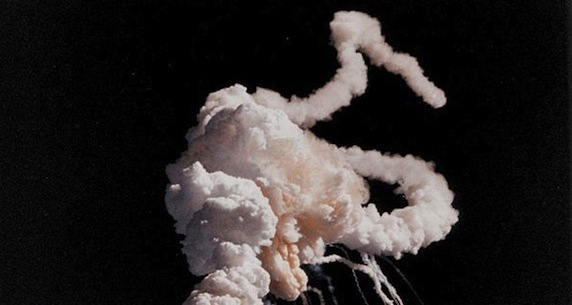This is part two in a two part series exploring the Challenger disaster. You can find part one here.
With the January 27th launch officially scrubbed and the overnight forecast calling for even more intense cold, the NASA administrators and Morton Thiokol engineers responsible for the Challenger mission faced an increasingly difficult situation. With the launch already rescheduled due to the weather, the shuttle would sit on the launch pad overnight, further chilling the MT built boosters well below the 40°F for which they were launch-certified.
Adding to the mix was a management team at MT that understood the political landscape of the day, even as they failed to understand the scientific one. Further, pressure from the Reagan White House to ensure the launch went off placed additional strain on the decision making process.
As temperatures dipped into the teens, icicles began to form on the platform and the tiles which provided the insulation for the space shuttle fleet to re-enter the atmosphere, causing a problem that wouldn’t rear its head on Challenger, but cost seven more lives when the Columbia disintegrated upon re-entry in February 2003.
Twice, once at 1:30AM and again at 8:30AM, safety teams went out to evaluate the icicle situation. Twice, those teams advised a ‘no go’ on the launch. Twice, they were ignored.
Meanwhile, at Morton Thiokol headquarters, business management and engineering management teams were meeting to discuss whether anyone in the engineering leadership structure would be willing to sign the waivers necessary for MT to give its authorization to launch the shuttle. After an initial discussion and vote resulted in MT not gaining the necessary approval to launch, the firm’s Vice-President of Engineering was advised to ‘put your management hat on’ before another round of discussion.
In parallel, and perhaps even more frightening, was the discussion taking place on the government side of the operation. From a Cape Canaveral hotel, NASA Administrator William R. Graham was working on doing exactly the job President Reagan had been sent there to do.
Graham had been affiliated with the administration for quite some time, working as an advisor to the President’s 1980 campaign and later as Chairman of the General Advisory Committee on Arms Control and Disarmament. As an administrator, he was loyal to the Reagan White House. Had he not been so, he wouldn’t have been sitting in the chair previously occupied by James Montgomery Beggs.
Beggs had served as NASA administrator for nearly five years when he was ousted in December of 1985, less than 2 months before the Challenger. In the eyes of several, the charges against Beggs for defrauding the government as an executive at General Dynamics was a sham trumped up to make room for Reagan’s man at the agency. The ultimate dropping of those charges in 1987 and ‘profound apology’ from AG Edwin Meese seem to bolster that claim.
Nevertheless, Graham was the man in that hotel overnight on January 27th. The same room which FBI investigators discovered 161 phone calls to and from that night, in fact. The Rogers Commission later discovered that ‘someone’ inside the White House told Graham to ‘get that damn thing in the air’.
Graham had his marching orders. The leadership at Morton Thiokol had theirs. The hours of deliberation led to a 73-second flight that found itself interrupted by the failure of the aforementioned O-rings, and the burning through the side wall of the solid-fuel rocket boosters. The ball of fire into which the shuttle erupted remains burned permanently into the brain of many Americans to this day.
Based on cabin recordings captured in Mission Control, the explosion didn’t kill the astronauts. Their capsule, heavily reinforced as it was, plummeted back to the Earth at over 200 MPH. A common theory, and the one held by our presenter on this night, is that the impact with the ocean is what caused them to perish.
President Reagan would not have his speech that night. Instead, the former actor had to perform in the role of the leader who mourned the losses of seven brave Americans, while his team strategized how best to distance the White House from the actions undertaken by the administration that led directly to the tragedy.
The resultant strategy was the Rogers Commission. Chaired by former Nixon Secretary of State William Rogers and retired astronaut Neil Armstrong, the commission would deliver a report that focused on the failure of NASA and MT to address design flaws. The commission would make a number of recommendations addressing the safety culture and the knowledge gaps between the management and the engineering staff at NASA.
What they would not do is look at the highest levels of the agency, nor the politicization of NASA that was allowed to occur under Reagan. A lone few would speak out in the months and years that followed, including Roger Boisjoly, a lead engineer at MT who predicted the disaster only a few months in advance.
Ultimately, the Challenger serves as a reminder of the failings of our leaders, especially those who find themselves consumed by the optics of a situation rather than the facts. That great lengths were taken to deny the American public of that lesson in favor of simple finger-pointing was a sad outcome that did a great disservice to the seven astronauts who perished on a cold day on January 28th, 1986.
Image: Wikimedia Foundation
